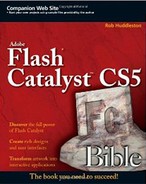Creating beautiful graphic designs and user interfaces is an obviously creative pursuit that combines a large degree of both natural talent and learned skills. Writing code, however, is every bit as creative a process as design. There is no one right way to write code.
Design and coding, however, require quite different skillsets and talents, and while there are some whose talent at design matches their talent at code, most find they excel at one or the other.
Flash Catalyst CS5 seeks to bridge the gap between the two, providing a means by which designers can utilize their skills in Illustrator and Photoshop to create rich designs, but avoid having to get deeply into what they likely consider the fairly intimidating world of writing code. Catalyst also provides a means by which coders who may not be great at design — who likely consider Illustrator to be every bit as intimidating as their design counterparts think of Flash Builder — can take the designs created by others and implement them in their projects.
Flash Catalyst CS5 is the first version of this product. Many, if not most, people today are used to working in programs that have been around for years, if not decades. They are used to finding a lot of people who have a deep understanding of the program and what it can do, and used to finding many resources available for it. As the new kid in the Adobe product line, Catalyst does not yet have that user base or the number of resources available as of yet.
You are getting in on the ground floor of this exciting new product.
Flash Catalyst CS5 is a product designed for people with little or no skill or desire to write code. It is aimed at designers — those people who love and use Illustrator and Photoshop — and provides them with a means by which they can create user interfaces for Rich Internet Applications without needing to know or learn code or the Flex framework. This book is targeted at precisely the same audience.
Catalyst does not let you edit code, so you will not find page after page of code samples here. Rather, Catalyst allows you to draw shapes, import images, add animation, and work with sound and video. This book, therefore, includes chapters on drawing shapes, importing images, adding animation, and working with sound and video.
This book is organized into six main parts:
In Part I, you'll find chapters that start you off right by letting you know what a Rich Internet Application is, why the Flex Framework was created, and how Catalyst fits in to the big picture. This part also discusses the other applications which you'll need in order to create Catalyst projects.
Part II gets you started in designing projects. Chapter 4 shows how you can use the drawing tools provided in Catalyst to create basic wireframes of applications, while Chapters 5, 6, and 7 take provide introductions to Adobe Illustrator, Adobe Photoshop, and Adobe Fireworks and show you how to use these programs to create the initial assets you will use in your Catalyst project.
Part III pulls those design assets together. In Chapter 8, you will learn how to import designs created in Photoshop and Illustrator into Catalyst. In Chapter 9, you begin converting those imported assets into components, the building blocks of Flex projects. Chapter 10 shows how to create view states, the pages that make up a complete Rich Internet Application, while Chapter 11 shows how you can leverage the fact that your project will ultimately end up in Flash Player to add animation. Chapter 12 teaches how to add sample data to your project, and Chapter 13 discusses adding Flash movies, sound, and video.
Part IV switches gears and moves into Flash Builder to show you how to complete the project. Chapter 14 introduces Flash Builder and the Flex framework, while Chapter 15 shows how to move the project from Catalyst to Builder. Chapter 16 shows how to return the project to Catalyst for further design work, and Chapter 17 discusses other export options. Chapter 18 introduces you to AIR, the Adobe Integrated Runtime, which allows you to use Catalyst as a part of a design process for creating desktop applications.
Part V provides a step-by-step tutorial for creating a complete project, from start to finish. Its chapters take you from creating the initial design in Illustrator to the completed project in Flash Builder, with detailed instructions and illustrations for each step along the way.
The files needed to follow along in each chapter, including Illustrator and Photoshop design files and Catalyst and Flash Builder Projects are included on the books Web site (www.wiley.com/go/flashcatalystbible). Completed versions of the project are also included so that you can see where you are going while you work.
